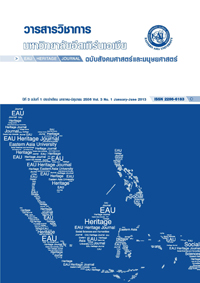กลยุทธ์การจัดการเรียนการสอนอาชีวศึกษา เพื่อผลิตแรงงานสาขาช่างอุตสาหกรรม ที่ตรงตามความต้องการของสถานประกอบการ
Keywords:
อาชีวศึกษา, การเรียนการสอน, ช่างอุตสาหกรรม, of industrial labor, Instructional Management, industrial technicians laborAbstract
บทความนี้รายงานการศึกษาแรงงานอาชีวศึกษาสาขาช่างอุตสาหกรรมที่ตรงตามความต้องการของ งสถานประกอบการ มีวัตถุประสงค์เพื่อ (1) ศึกษาคุณลักษณะแรงงาน (2) ศึกษาองค์ประกอบของแรงงาน และ (3) กำหนดกลยุทธ์การจัดการเรียนการสอนของวิทยาลัยเทคนิคสาขาช่างอุตสาหกรรม โดยใช้การสัมภาษณ์ตัวแทน จากสถานประกอบการจำนวน 60 แห่งและแบบสอบถามและเก็บข้อมูลจากสถานประกอบการจำนวน 60 แห่ง ผู้ตอบแห่งละ 17 คน ผลการวิจัย พบว่า (1) คุณลักษณะแรงงานอาชีวศึกษาตามความเห็นของสถานศึกษาแบ่ง ออกเป็น 9 คุณลักษณะใหญ่ 36 คุณลักษณะย่อย ในขณะที่คุณลักษณะแรงงานอาชีวศึกษาตามความต้องการของ สถานประกอบการแบ่งออกเป็นห้าคุณลักษณะใหญ่ 49 คุณลักษณะย่อย (2) คุณลักษณะแรงงานมีองค์ประกอบ ที่สอดคล้องกันได้แก่ ด้านจริยธรรมการปฏิบัติงาน ด้านบุคลิกภาพ ด้านความรู้พื้นฐาน ด้านการปฏิบัติตนตาม กฎระเบียบของสังคม และด้านทักษะในการปฏิบัติงาน อีกห้าองค์ประกอบที่เป็นที่ต้องการของสถานประกอบการ ได้แก่ ความซื่อสัตย์ในการปฏิบัติงาน ความเข้าใจในหน้าที่ของตน ความรู้และทักษะทางช่าง ความสนใจในด้าน เทคโนโลยีใหม่ๆ และทักษะด้านงานฝีมือ (3) กลยุทธ์ที่สร้างขึ้นแบ่งออกเป็นสามส่วนได้แก่ องค์ประกอบที่สอดคล้องกัน ทั้งห้าข้อถือว่าเป็นสิ่งที่ดีแล้วให้คงอยู่ไว้ ส่วนที่สอง องค์ประกอบที่ยังเป็นความต้องการของสถานประกอบการ แต่ไม่เป็นไปตามสถานศึกษาห้าข้อก็จะต้องมีการเน้นจัดการเรียนการสอนในด้านเหล่านั้นเพิ่มเติม และส่วนที่สาม องค์ประกอบสองข้อที่มีในสถานศึกษาแต่ไม่ตรงกับสถานประกอบการก็ให้คงไว้ได้ ผลการตรวจสอบความเหมาะสม โดยผู้ทรงคุณวุฒิพบว่ากลยุทธ์มีความเหมาะสม ความถูกต้อง ความเป็นไปได้และสามารถนำไปใช้ได้
An Instructional Management Strategy of Vocational Industrial Education as Relevant to the Entrepreneurs’ Needs
This paper reports the study on aiming to (1)examine the characteristics of industrial labor, industrial technicians labor that was in line with the requirements of entrepreneurs analyze, (2) the factors of industrial technicians labor, and (3) design the strategy of learning and teaching of technical colleges of industrial technicians labor line with the requirements of entrepreneurs. The first phase was the literature review and interviews of representatives of entrepreneurs in order to find the characteristics of industrial technicians labor that was in line with the requirements of entrepreneurs. After that, two instruments were created to from questionnaires when used to collect data 60 education institutions with the respondents of 12 persons from each institution, and from 60 entrepreneurs with the questionnaire respondents of 17 persons Collected data were analyzed using with factor analysis and the relationships of the factors from the education institutions and entrepreneurs were analyzed and used to design the strategy for learning and teaching. The results show that: (1) The characteristics of industrial technicians labor in line with the requirements of entrepreneurs were divided into five major characteristics and 49 minor characteristics. (2) The labor characteristics from the opinions of education institutions were grouped into seven factors and the labor characteristics from the opinions of entrepreneurs were grouped into 10 factors, in which five factors were found to be consistent, that is, work ethics, personality, basic knowledge, demeanor according to social norms, and job skills. The other factors that entrepreneurs needed but did not correspond with the opinions of education institutions were work faithfulness, job understanding, technical knowledge and skills, interest in new technology, and manual skills. The other two factors from the opinions of education institutions that were not consistent with those of the entrepreneurs were characteristics of occupational attitude and practical knowledge in the industrial sector. (3) The results of testing the appropriateness by the qualified experts found that the strategy was suitable, correct, possible, and applicable, with the Cronbach’s alpha of 0.937 and the concordance statistical value of 0.883 exceeding 0.75, showing that the developed strategy for learning and teaching of the vocational education in the industrial technicians was effective.





